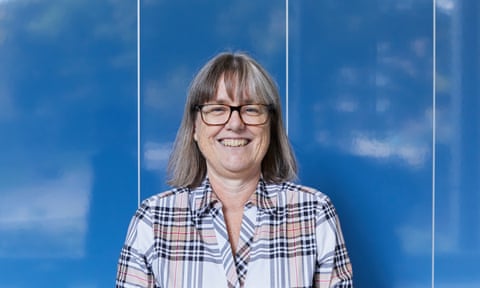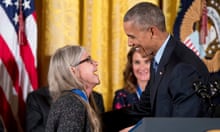When you win a Nobel prize, you can expect a fair bit of attention. When you are a woman and you win the prize in physics, as the Canadian professor Donna Strickland did earlier this month, you can expect the level of attention to be overwhelming.
The day after the announcement, just about everyone Strickland knew – and several people she did not, including Justin Trudeau, the prime minister of Canada – called or emailed with congratulations. The day after that, her inbox overflowed with thousands more messages. The interview requests were similarly incessant; Strickland expects to be travelling non-stop, talking at schools and scientific organisations about her work, for the next two or three years. For a self-described recluse, the frenzy was all a bit much. “Two or three weeks ago, I was an ordinary human being and now I’m not,” she says with a laugh.
“Ordinary human being” is characteristic Strickland self-deprecation. Long before the Nobel bestowed its honour, the 59-year-old was considered one of the world’s foremost laser physics pioneers. The research that the Nobel committee recognised was published in 1985, when Strickland was still a doctoral student at the University of Rochester in upstate New York. Along with her supervisor and mentor Gérard Mourou (with whom she shared the Nobel), Strickland figured out a way to generate ultra-short, high-intensity laser pulses without destroying the material amplifying them. The idea was Mourou’s, she says, but “I got to make it work”.
Their revolutionary technique, called chirped pulse amplification (CPA), led to the creation of small, incredibly powerful lasers now used in corrective eye surgery, industrial machining and medical imaging. (Arthur Ashkin, a US scientist, was also awarded the physics prize this year, for the development of “optical tweezers” – using light to manipulate small objects.)
Before her Nobel win, Strickland’s time was split between classroom and lab, but on this day in the middle of October we are sitting in the sunnier, more interview-friendly office of the university’s chancellor. She is wearing the sensible black trousers and black shoes of a lifelong academic, a shirt with a Burberry-like pattern (it is not Burberry: “I would never spend money on that”) and thick glasses (she refuses to get the corrective surgery her work made possible: “I have great faith in lasers, but no one’s putting one near my eye”). She laughs often, speaks quickly and is unfailingly courteous – she even apologises for drinking coffee during our chat. When she talks about lasers, it is with the excitement and affection most people reserve for their pets.

Strickland is only the third woman to win the Nobel in physics. The first was Marie Curie, in 1903; the second was the German-born US physicist Maria Goeppert-Mayer, who won in 1963. The fact that female scientists are so often ignored by the Nobel committee, coupled with studies that show women in Stem (science, technology, engineering and mathematics) experience more discrimination, ensured that a lot of the discussion around Strickland’s prize concerned gender. News stories drew attention to the fact that, despite having received numerous accolades before her Nobel win, Strickland was not deemed worthy of a Wikipedia page until this month (an attempt by a user to create a profile for her in March was denied by a moderator). Also highlighted was the fact that she was still an associate professor at the University of Waterloo in Ontario, rather than a full professor. It did not help that, in September, the Italian physicist Alessandro Strumia gave a conference lecture at Cern, the European Organization for Nuclear Research, in which he said men were now being discriminated against because of their gender and that physics was “invented and built by men”. (Cern subsequently suspended him.)
Strickland was surprised by the focus on gender. “I know there is certainly a lot of effort right now being placed on equity, diversity and inclusivity,” she says. “We consider that in our hiring practices and I’ve sat on many of the hiring committees. I was on the board of the Canadian Association of Physicists and we really discussed, as a board, how to incorporate these ideas. So, I’m certainly aware of the climate. But I don’t see myself as a woman in science. I see myself as a scientist. I didn’t think that would be the big story. I thought the big story would be the science.”
Strickland’s focus has always been the science. She was born in Guelph, Ontario, a university town about an hour’s drive from Toronto. Her father was an electrical engineer and her mother was an English teacher. According to family lore, when Strickland was a child, they took a trip to the then recently opened Ontario Science Centre. Her father showed her the museum’s big laser, saying: “You’ll want to see this. Lasers are the way of the future.” Strickland barely remembers the trip, but evidently something sunk in. Later, when she enrolled as an undergraduate at McMaster University in Hamilton, Ontario, she was torn between electrical engineering (lots of jobs) and physics (more fun). Fortunately, McMaster offered a hybrid programme – engineering physics – so she did not have to choose. Better yet, electro-optics and lasers was an area of study within the course. “I was like: ‘Oh my God, that sounds cool,’” Strickland says.
When Strickland entered graduate school, the Canadian space programme was just starting up and her father often asked if she wanted to be an astronaut. No, she said, she was claustrophobic and afraid of heights – going into space sounded like a nightmare. All she wanted to do was stay in school. She was good at it, especially maths and science. When someone told her that a PhD was “the ultimate in school”, that degree became her ambition. Despite a few years on the edge of academia after Rochester, she never really left school. In 1997, she was hired by Waterloo, where she now runs the ultrafast laser group, the goal of which is, essentially, to create lasers that people have never seen before.
From her first Nobel press conference onwards, Strickland has insisted that she has been treated as an equal throughout her career; she has always been paid the same as her male colleagues, always been given the same opportunities. Her Nobel win is a symbol of progress, she says. Nonetheless, she has encountered men who share the defensive fragility demonstrated by Strumia in his Cern lecture. On one occasion during her undergraduate years, for example, a male student whom she had outperformed in a notoriously tough applied maths class was so furious that he threatened to “pound” her. Strickland was shocked, but also inwardly delighted: “All I could think was: ‘Girl beat you. Girl beat you bad.’”
A significant obstacle for women that she highlights is the “two-body problem”. Given that men outnumber women so heavily in physics, straight women who want to marry have a much wider choice among their colleagues then straight men do. If they marry a fellow physicist, however, it becomes almost impossible for the couple to find long-term university jobs at the same time, due to the relative scarcity of academic roles. Almost always, a wife’s career is subordinated to her husband’s – which is another reason for the smaller number of women in science.
Strickland met her future husband, the electrical engineer and scientist Doug Dykaar, at university. (They have two university-age children: a son who is studying comedy and a daughter who is doing graduate work in astrophysics.) In the years following their marriage, Dykaar was able to get hired by universities, but there was never an additional position available for Strickland. That situation was reversed when Strickland was hired by Waterloo and Dykaar left academia for industry. “Every so often, he’ll go: ‘When is it my turn?’” Strickland says, laughing. “But I’ve got tenure, Doug, so, when it’s your turn, make sure it’s really safe for us to travel [to another school].” (She is a full-time tenured professor. The only reason she does not have the title of “full” professor is because she has never applied for the rank. The university’s president has said that, if she wanted to apply, her CV would need only be one line long: “Awarded Nobel prize in physics, 2018.”)
Strickland would much rather talk about science than gender issues. When I ask her to describe some research she has done that is as cutting-edge as CPA, she launches into an impromptu, 10-minute lecture on a couple of experiments. I have not studied physics for about 30 years, so while I am more or less familiar with the words she uses – waveform, light, colour, intensity, pulse – her use and combination of them is baffling. She is patient, though, and almost giddy in her explanation – her eyes brighten, her smile never droops. She has said that her job is to impart her excitement about lasers to her students; in these few minutes, I feel a tingle of that excitement.
Strickland clearly misses the classroom. She regrets that, with all the Nobel nonsense going on, she is able to spend only about an hour a day in her lab, checking in with her group. “I’m trying my best not to abandon them,” she says. She will get back there eventually. In the meantime, there are more interviews, more photoshoots, more talks. She has to go shopping for ball gowns – three for herself, as well as ones for her daughter and her sister. There are a lot of events during Nobel week in December – balls, lectures, concerts, dinners, a meet-and-greet with the Swedish royal family. “I’ve asked a couple of other Nobel laureates for advice,” Strickland says. “They all say the same thing: ‘Pace yourself. You can only do so much.’”








